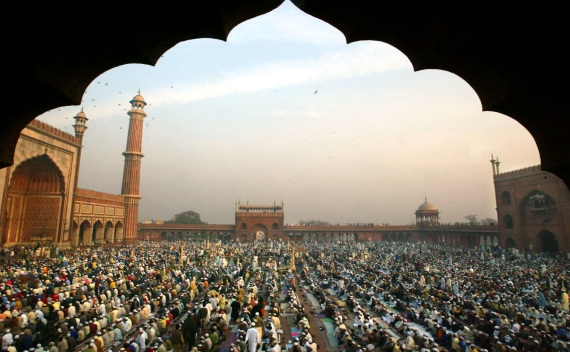Impressions of an Amateur India-Watcher
More on:

I recently returned from a trip to New Delhi, India, where I was fortunate to have the opportunity to listen firsthand to officials, academics, journalists, and entrepreneurs. I spent part of my time in New Delhi with other CFR fellows at a workshop related to our new Center for Preventive Action report: Managing Instability on China’s Periphery. (See Elizabeth Economy’s reflections in an earlier blog post.) In addition, I was privileged to be selected as a participant in the first annual Asian Global Governance Forum, which consisted of forty smart and ambitious “young leaders” from all corners of the world.
On the eve of Diwali—popularly known as the “festival of lights”—I wanted to offer five impressions as a semi-informed observer on India’s role in the world:
First, India’s foreign policymaking infrastructure is underdeveloped relative to its prospective global role. My first day in New Delhi, we met with officials from the Ministry of External Affairs (MEA). The MEA is smaller than the U.S. Embassy in India and there are supposedly only three staffers focused on relations with the United States (much to the frustration of American officials tasked with soliciting official Indian opinion in short order). A common response to questions about India’s position on several topics is, “We haven’t thought through our opinion on that.” Although there are plans to double the size of the Indian Foreign Service and the MEA has a new, semi-occupied headquarters, the foreign policy establishment has much room for growth.
Second, after speaking with Indians who are deeply engaged in foreign policy issues, I was surprised by how rarely Pakistan was mentioned. In India, Pakistan is largely perceived as weak because it cannot—or will not—fight certain domestic militant groups that threaten the government or its neighbors. The primary threat to India is not from the Pakistani military or its nuclear arsenal, but rather from nonstate actors such as Lashkar-e-Taiba, the Pakistan-based terrorist organization that perpetrated several attacks on Indian civilian and military facilities, including the Mumbai attacks in November 2008 (known as 26/11) that killed 166 people. In short, most Indian officials would prefer a strong Pakistan that could reduce the domestic instability spilling over its borders.
Third, India and China are increasingly facing serious disagreement on several periphery issues. In the personal opinion of one Indian official: “China will not be a status-quo power. It will seek fundamental primacy by challenging the power equations on its periphery.” One such area is what Indians refer to as “Pakistani-Occupied Kashmir,” where roughly ten thousand People’s Liberation Army troops and engineers are engaged in so-called “infrastructure development,” which could also serve to facilitate conventional troop movements from China to Kashmir in a crisis.
The South China Sea is another source of extreme tension between India and China. For over twenty years, India’s Oil and Natural Gas Corporation and Vietnam have maintained a joint venture for hydrocarbon exploration in two offshore blocks in the economic exclusion zone claimed by Vietnam. However, China also claims one of the offshore blocks as part of its territorial waters. The territorial dispute recently escalated when a Chinese warship confronted an Indian naval vessel off the coast of Vietnam in late July. Although there are conflicting accounts of the incident, reportedly an unidentified person claiming to represent the People’s Liberation Navy warned the Indian vessel over an open radio channel that it was in Chinese waters and must leave immediately. The Indian Navy ignored the warning, but the reports only served to strengthen the suspicions of many Indians about China’s increasing influence.
Fourth, American policymakers who aspire to strengthen relations with a rising India to counterbalance a rising China will be disappointed. India wants to engage with other states in its own way, on its own terms. It recently held the first Strategic Economic Dialogue with China and a Global Partnership Summit with Japan, and plans to host the next BRIC Summit in 2012. Both Indian and American officials welcomed the strengthened partnership initiated by President George W. Bush, but also recognize the need to be realistic about how often U.S. and Indian interests overlap, as well as how quickly India can develop a more active role in international affairs. In this regard, overt American efforts to leverage India against China can be expected to trigger a reflexive, nationalist resistance in Indian government officials.
Fifth, every Indian with whom I met emphasized the principles of sovereignty and non-interference as of the utmost importance. They were particularly concerned with and suspicious of the long-term impact of the Arab Spring on stability in North Africa and the Middle East. Specifically, most consider the NATO intervention in Libya to be a mistake, and believe that efforts to build a democratic government will fail. Closer to home, Indians have consistently resisted American pressure for political reforms in Myanmar, as they prefer a stable country over an unpredictable democracy. Indians are wildly enthusiastic about democracy and transparent voting—65% of parliamentarians lose every time they run—but the government has no interest in supporting its imposition abroad. In the words of a cabinet member on my final day in India, “It is not our job to export our democracy to other parts of the world.”
Happy Diwali!
For reflections on my recent trip to Beijing, China, please see his post: Impressions of an Amateur China-Watcher.
More on:
 Online Store
Online Store